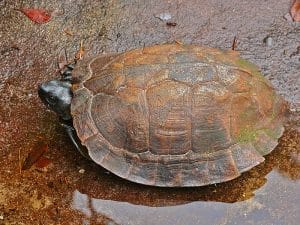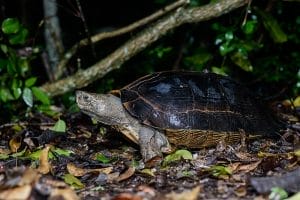Heosemys depressa (Arakan Forest Turtle)
Home > Turtle Database > Heosemys depressa (Arakan Forest Turtle)
The Arakan forest turtle (Heosemys depressa) is a critically endangered species native to the dense forests of Myanmar. Once thought to be extinct, it was rediscovered in the wild in 1994, bringing attention to its precarious existence and the urgent need for conservation efforts.
Native To These Regions
Rakhine State (Myanmar)Native Turtle Species Map – Find Turtles by Region
Scientific Classification
- Kingdom: Animalia
- Phylum: Chordata
- Class: Reptilia
- Order: Testudines
- Family: Geoemydidae
- Genus: Heosemys
- Species: Heosemys depressa
Common Names
- Arakan Forest Turtle
- Myanmar Brown Turtle
This Hilarious Turtle Book Might Know Your Pet Better Than You Do
Let’s be real—most turtle care guides feel like reading a textbook written by a sleep-deprived zookeeper.
This one’s not that.
Told from the snarky point of view of a grumpy, judgmental turtle, 21 Turtle Truths You’ll Never Read in a Care Guide is packed with sarcasm, sass, and surprisingly useful insights.
And hey—you don’t have to commit to the whole thing just yet.
Grab 2 free truths from the ebook and get a taste of what your turtle really thinks about your setup, your food choices, and that weird plastic palm tree.
It’s funny, it’s honest, and if you’ve ever owned a turtle who glares at you like you’re the problem—you’ll feel seen.
Identification
Description
The Arakan forest turtle has a broad, flattened carapace that is brown to dark brown in color. Its shell is relatively smooth with a slight keel running down the center. The plastron (underside of the shell) is lighter, often yellowish-brown. The head is large with a somewhat pointed snout and features a hooked upper jaw. Skin coloration ranges from gray to brown, complementing its shell for camouflage in forest environments.
Sexual Dimorphism
Males typically have a longer and thicker tail compared to females. Additionally, the vent (cloacal opening) in males is located further from the base of the tail, which is a common trait in many turtle species.
Check more turtles from the Heosemys genus
Native Origin and Distribution
Geographical Range
Heosemys depressa is endemic to the Arakan Mountains in western Myanmar. Its range is extremely limited, confined to this specific region’s subtropical and tropical forests.
Preferred Habitat
This species inhabits moist, evergreen forests and is often found near streams and rivers. It prefers dense underbrush and leaf litter, which provide both food sources and protection from predators.
Behavior
Feeding Habits
The Arakan forest turtle is omnivorous. Its diet includes a variety of plant matter such as fruits, leaves, and fungi, as well as animal matter like insects, worms, and other small invertebrates.
Predators
Natural predators are not well-documented but likely include larger mammals and birds of prey native to Myanmar’s forests. Human activities pose the most significant threat through hunting and habitat destruction.
Reproduction
Breeding Season
Specific details about the breeding season are scarce due to the species’ elusive nature. However, it is believed that mating occurs during the rainy season when conditions are favorable.
Reproductive Method
Females lay small clutches of eggs, typically ranging from 2 to 4. The eggs are buried in moist soil, and the incubation period remains largely unknown.
Conservation
Extinction Status
- IUCN Red List: Critically Endangered
Threats
- Habitat Loss: Deforestation for agriculture and logging reduces available habitat.
- Hunting: Collected for local consumption and the illegal pet trade.
- Low Reproductive Rate: Small clutch sizes make population recovery slow.
Conservation Measures
- Legal Protection: Listed under Myanmar’s wildlife protection laws.
- CITES Listing: Included in Appendix II, regulating international trade.
- Breeding Programs: Initiatives to breed the species in captivity are underway to bolster population numbers.
Economic Importance
While not economically significant on a large scale, the Arakan forest turtle is sometimes hunted for local food markets and sold in the illegal pet trade, which can provide income for local communities but contributes to the species’ decline.
Interesting Facts
- The species was thought to be extinct for over 90 years until its rediscovery in 1994.
- Due to its rarity, there is limited scientific knowledge about its ecology and behavior, making conservation efforts more challenging.
- The Arakan forest turtle’s ability to remain undetected for so long highlights the rich biodiversity yet to be fully explored in Myanmar’s forests.

About Author
Muntaseer Rahman started keeping pet turtles back in 2013. He also owns the largest Turtle & Tortoise Facebook community in Bangladesh. These days he is mostly active on Facebook.















